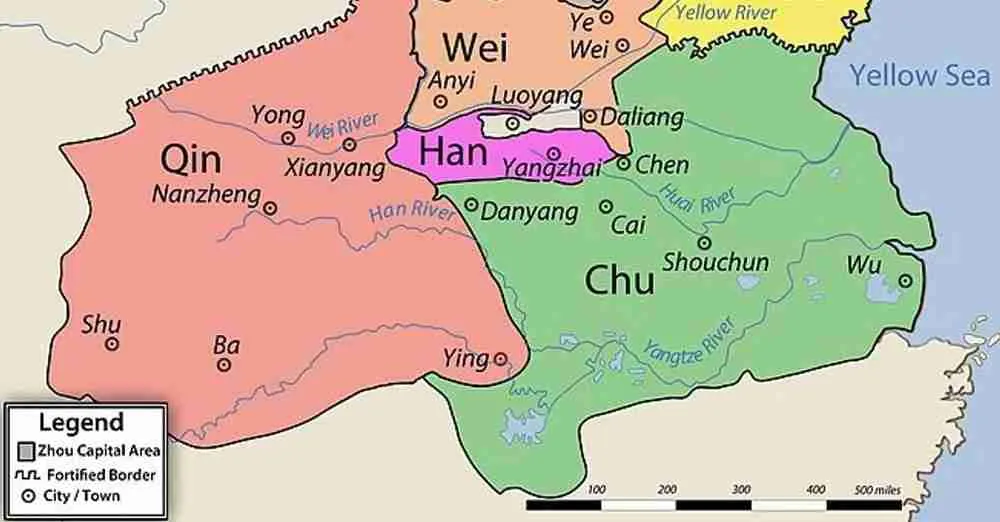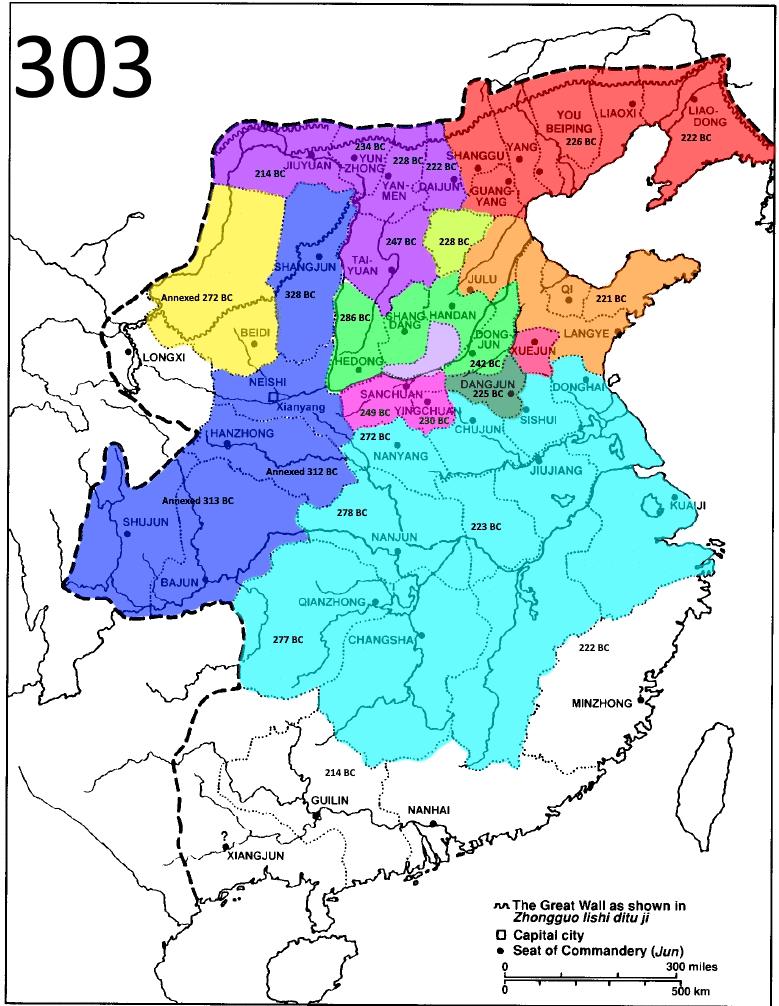The Warring States Period of China is one of the most remarkable times in China’s history, being the period that led to a more unified China.
What Was The Warring States Period?

The Warring States Period of between 481/403BCE and 221BCE can be defined as the three long centuries during which many rival states were in constant vicious battles for territorial dominance and advantage. The Warring States Period is, therefore, also called the Contending States Period and, in Chinese, Zhanguo or Chan-Kuo. And at the end of the warring period, the state of Qin emerged victorious, establishing the first-ever unified state of China.
While the Warring States Period faced incessant warfare for three whole centuries, the warfare is what made the Chinese state what it is today. This is because despite being the longest warring period, it was also the period during which the Chinese communities and regions saw the most significant developments made in agriculture, commerce, the arts, and philosophy. And all these developments are what set the foundations for the flourishing Chinese nation that was named Imperial China. The influence of the Warring States Period in Chinese history not only resulted in a thriving unified state of China, but it was also during this period that the great Chinese thinkers and philosophers like Confucian thinkers Xunzi and Mencius rose to success. The Warring States Period is also what led to the establishment of more stable governmental structures, as well as cultural patterns which would characterize and influence the success of China for at least 2000 more years.
Note that the Warring States Period is distinguished from the era or period that preceded it, the Spring & Autumn Period (Chunqiu) of the 770-476BCE Period, which was a time when the Chinese state was heavily subdivided into even smaller states.
Warring States Meaning
The Warring States were made of at least 7 main feuding Chinese states, although the number was higher if you count the smaller states that took part in the feud.
Why the name ‘Warring States’? Well, this name given to the feuding states period comes from the ancient Chinese works from the Han Dynasty termed as Zhanguoce or the Intrigues (Records) of the Warring States. And in these intrigues, the two bigger and more powerful states of Qin and the Chu are the ones that won the war. And later on, the state of Qin defeated all the other states in 221BCE, establishing China’s first-ever unified state.
Why Did The Warring States Period Start?
This historical period that was characterized by warfare, a great deal of bureaucratic and also military consolidations, and reforms is reported to have started in 481BC/403BC to 221BCE, although there are citations in the Sima Qian which show that the Warring States started in 475BC.
It’s also worth noting that the Warring States period overlaps with the Eastern Zhou Dynasty’s 2nd half of there, although at the time, the Chinese sovereign, King Zhou, was just a figurehead who served as more of a backdrop against the warring states’ machinations.
What Caused The Warring States Period?
There might have been several other contributing factors, but the Warring States Period was sparked by actions of the vassal states from the Zhou Dynasty when they were able to declare independence from the primary Zhou Dynasty. This led to the collapse of the dynasty into more than 100 smaller states, all of which claimed to have the right to rule thanks to something called the Mandate of Heaven. The Mandate of Heaven is a spiritual and political doctrine that had been in use for close to millennia and was used to recognize and legitimize the leaders. The mandate claimed that the people who’d been given the mandate had been ordained in heaven, literally, and they’d therefore take power over the people and states at any time/ moment.
Note that before this massive split, China had three main ruling dynasties, although most people claim that there were only 2 main states. But all the 100+ warring states were unified into one state at the end of the warring period, which was in the year 221BC.
In other words, the warring period was triggered by the declaration of independence from the Zhou Dynasty by smaller states, and it started with the smaller kingdoms fighting for the territory.
While the Western Zhou Dynasty’s Period between 1046 and 771BC was quite successful, especially with the social hierarchy and the feudal system (fengjian) running from top to bottom (King and nobles to Laborers and Peasants), with separate legal systems, militia, tax codes, and currency, the prosperity from this system was rather short-lived, with the Western Zhou being invaded by the Xirong who destabilized Western Zhou significantly, forcing the nobility to move the state capital to the East in Luoyang, establishing Eastern Zhou Dynasty.
Unfortunately, moving the capital to the East didn’t change much. If anything, the violence and chaos only worsened, and the state’s only successes were the production of the best artistic, literary, and some philosophical works whose substance and originality were quite startling. The decorum that had been created from Western Zhou was temporary, and soon the state broke into smaller, separate states – Han, Chu, Qin, Qi, Yan, Wei, and Zhao. These states were more powerful than Zhou’s ruler. Then in the early days of the Autumn & Spring period, there was some chivalry in battle, but the same stalemates were faced as they engaged in battle, and this led to the Warring States Period that was characterized by futile and endless warfare. This is all recorded in the book the Art of War by Sun-Tzu.
When Was The Warring States Period In China?
The Warring States Period of China spans a period of 3 centuries between 481BC and 221BC. It started towards the end of the reign of the Zhou Dynasty, or rather, the last three of the reign of the Zhou Dynasty between 1046 and 221BC – This period is now classified into the Western Zhou Dynasty (1046-771), the Spring & Autumn Period between 772 and 446BC, and the Warring States Period.
When Did The Warring States Period Begin?
There is no consensus regarding the exact time of year that the Warring States Period started, and while some historians note that it started in 481BCE, others claim that it started in 475BCE.
When Did The Warring States Period End?

It ended in 221BC when the rulers of the Qin Dynasty won over the rest of the feuding states, creating one unified China.
When Did The Warring States Period Start And End?
The period started in 481BCE/403BCE and ended in 221BCE.
What Happened During The Warring States Period?
As the Eastern Zhou crumbled (771-256), the country was forced into war because different kings wanted to rule over China. With the dynasty losing their military backing and being forced to rely on allied states’ armies, the Zhou King at the time was forced to make a military state from an allied state, the leader of the Zhou Military alliance. These commanders swore loyalty to the Zhou feudal system. But things changed early in the 4th Century BCE when at least 100 smaller states got consolidated into 7 main states by what’s referred to as the Conquest. Between the 7 bigger states were other smaller states, but these were absorbed by the bigger states. These changes encouraged territorial segregation further, and several hundred long defensive walls were put up along the frontiers.
In these 7 states, each of the rulers declared themselves the king and the independent ruler of the Zhou empire, and to do this; they looked for new ways of expanding their territories. The attacks their rivals over succession conflicts that resulted from the intermarriage between the different royal families. The conflicts and rivals resulted in ever-shifting alliances, and there was always conflict somewhere. So, between 535 – 286BCE, China has at least 358 wars/ disputes between the states. All this time and during the periods of momentary peace, the commanders would abandon their chivalrous etiquette, campaigning ruthlessly and destroying their enemies, including non-combatants and the soldiers.
The biggest armies featured cavalries with mounted archers sitting on the sturdiest of Mongolian Steeds, new iron weapons like crossbows and swords, and later on, armor. And soon, the predictable infantries were replaced by the more dynamic troops on the battlefield with not just stronger soldiers but also the most effective and powerful weapons. The tactics employed were also sophisticated, and the troops more disciplined. Subterfuge and a lot of espionage were also employed by the warring states, with chivalry hanging on by a thread.
One of the biggest changes that took place as the warring period trudged along has to be the increase in the number of armies going into battle, and troops would have over 200,000 men in each infantry rather than the 10,000 that was the case previously. The states that had the biggest numbers of troops were the Qin, Chu, and Qin, and each had powerful infantries with almost a million men with cavalry forces of 10,000. And so, thanks to the numbers, battles dragged on for months or years rather than days, and the casualties were in tens of thousands. Armies were forced to fight on multiple fronts, a move that would increase the state’s ability to win over territories while also obliterating the enemies’ military capacity.
Notably, the soldiers were only half-baked in terms of training, which meant that the warfare had to do with the numerical supremacy of the states over the fighting skills. Obviously, the ordinary populace took on a heavy toll – all males were expected to fight for their state, and crops/ property destroyed.
So, in one of the greatest battles of the period, the battle of Changping, Qin state conscripted all males over the age of 15, and even the farmers had to go to war. Rankings systems remain operational, and soldiers who fought well were rewarded with land and big military ranks. So, cutting off the head of the enemy was rewarded by a rise up the ranking ladder and 5 acres of land.
But the soldiers are not the only ones that were incentivized; the commanders too, and they had to demonstrate the possession of military skills that earned them the commander rank. And thanks to this strategy, the troops gained even more advantage over their enemies.
In the most ironic turn of events, the Qin ruler is the only one who remained loyal to the Zhou Dynasty, with both Duke Xin and his successor Xiao protecting Zhou’s interests and rewarded.
To win, Qin’s rulers took advantage of the protective mountain range on the Eastern border, and as one of the peripheral states, they expanded with more ease. They also had a very organized and strong Legalism government, and in 316BCE, they won over Shu state, absorbing their uber-fertile land and enriching the state forth. In 278BCE, they won over Ying; then, after a 3-year battle, they won over Zhao in 260BCE. In 256BCE, Qin took over what remained of the Zhou state after their king died. Their biggest final and decisive win was in 230BCE and 225BCE when they won over the Han and Wei. They capitulated the Chu state in 223CBE, which was their biggest rival, and their defeat over Yan in 221BCE earned them victory, and they got to rule a unified state of China, with Zheng earning the title of the First Emperor.
Seven Warring States(7 kingdoms china)
Qin, Wei, Zhao, Chu, Han, Qi, and Yan.
Who Won The Warring States Period
Qin Dynasty won the battle in 221BCE, and this led to the transition between Ancient China and Imperial China.